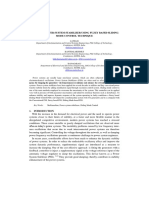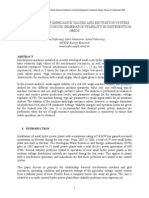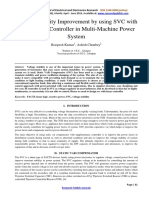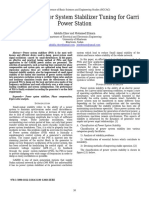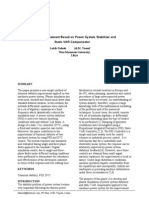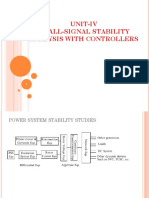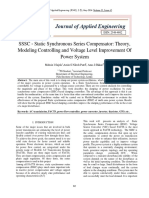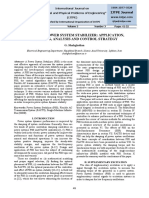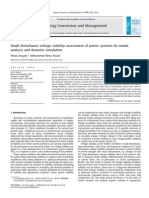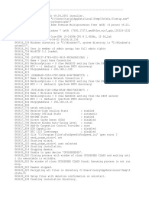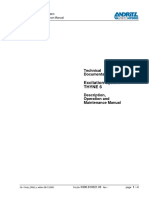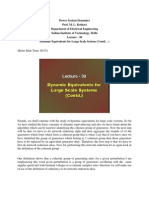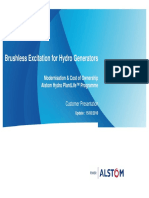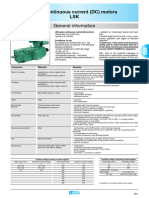Study On Oscillation Damping Effects of Power System Stabilizer With Eigenvalue Analysis Method For The Stability of Power Systems
Study On Oscillation Damping Effects of Power System Stabilizer With Eigenvalue Analysis Method For The Stability of Power Systems
Uploaded by
Mahmoud Al-QudahCopyright:
Available Formats
Study On Oscillation Damping Effects of Power System Stabilizer With Eigenvalue Analysis Method For The Stability of Power Systems
Study On Oscillation Damping Effects of Power System Stabilizer With Eigenvalue Analysis Method For The Stability of Power Systems
Uploaded by
Mahmoud Al-QudahOriginal Description:
Original Title
Copyright
Available Formats
Share this document
Did you find this document useful?
Is this content inappropriate?
Copyright:
Available Formats
Study On Oscillation Damping Effects of Power System Stabilizer With Eigenvalue Analysis Method For The Stability of Power Systems
Study On Oscillation Damping Effects of Power System Stabilizer With Eigenvalue Analysis Method For The Stability of Power Systems
Uploaded by
Mahmoud Al-QudahCopyright:
Available Formats
Study on Oscillation Damping Effects of Power System Stabilizer
with Eigenvalue Analysis Method for the Stability of Power Systems
63
X4
Study on Oscillation Damping Effects of Power
System Stabilizer with Eigenvalue Analysis
Method for the Stability of Power Systems
Fang Liu1, 3, Ryuichi Yokoyama1, Yicheng Zhou2, Min Wu3
1Waseda
University
Japan
2Tepco Systems Corporation
Japan
3Central South University
China
1. Introduction
With the increasing of the scale and the complexity of the interconnected power networks,
the problems on the various potential power oscillations, which have the nervous damage
against the system stability and the security operation, have been drawn more and more
attention (Kunder, 1994; Anderson & Fouad, 2003; Bikash & Balarko, 2005). Power system
oscillations were first reported in northern American power network in 1964 during a trial
interconnection of the Northwest Power Pool and the Southwest Power Pool (Schleif et al.,
1966). Up to now, generally speaking, power oscillations could be divided into three kinds
of types, that is, local mode, inter-area mode, and global mode. Local oscillations lie in the
upper part of that range and consist of the oscillation of a single generator or a group of
generators against the rest of the system. In contrast, inter-area oscillations and global
oscillations are in the lower part of the frequency range and comprise the oscillations among
groups of generators. As a classic oscillation mode, there are relative mature technologies
and devices such as kinds of power system stabilizers equipped as a part of the additional
excitation system of machine unit to provide the efficient damping ratio to suppress the
local oscillation. Nevertheless, as for the inter-area and the global oscillation mode, the
classic stabilizer cannot play an important role to damp such oscillation very well. The
leaded result is that the line power transmitted from one area to another will form the
instable oscillation with the unease attenuation characteristic.
As a result, if there is no the effective solution to suppress these power system oscillations,
the instability could lead the machine unit cut even the networks breakout. Nowadays,
severe consequences have been coursed by large-scale blackouts, such as blackouts in the
USA, Europe and many other countries in recent years. Moreover, blackouts not only lead to
financial losses, but also lead to potential dangers to society and humanity. So it is necessary
to pay attention to keep the stability and security of the electrical power systems. Up to now,
many authors are trying to develop new methods to enhance the various types of
www.intechopen.com
64
Modelling, Simulation and Identiication
oscillations in power system. Various theories and technologies are introduced to against
such power oscillations, such as wide area measurement systems (Ray &Venayagamoorthy,
2008; Kawma & Grondin, 2002), FACTS devices (Pourbeik & Gibbard, 1996; Pourbeik &
Gibbard, 1998; Zhang et al., 2006), robust controllers and the design technologies (De
Oliveira et al., 2007; Pal et al. 1999), and so on, to enhance the stability and the security
operating ability of the close-loop systems.
In this chapter, we will deal with the application of power system stabilizer to improve the
power system damping oscillation by using eigenvalue analysis method. This paper is
organized as follows: In Section II, the operating principle and main structure types of
power system stabilizer (PSS) will be described briefly. In Section III, the eigenvalue analysis
method based on small single model will be introudeced. In section Section IV, the detail
nonlinear simulations on two typical test systems will be performed to evaluate the
performance with installing powes system stabilizer (PSS). In Section V, we will give some
conclusions.
2. Power System Stabilizers
2.1 Operating Principle
The basic function of power system stabilizer (PSS) is to add damping to the generator rotor
oscillations by controlling its excitation by using auxiliary stabilizing signal(s). Based on the
automatic voltage regulator (AVR) and using speed deviation, power deviation or
frequency deviation as additional control signals, PSS is designed to introduce an additional
torque coaxial with the rotational speed deviation, so that it can increase low-frequency
oscillation damping and enhance the dynamic stability of power system. Fig.2.1 shows the
torque analysis between AVR and PSS.
MP
MP2
Me2
Fig. 2.1. Torque analysis between AVR and PSS
As shown in Fig.2.1, under some conditions, such as much impedance, heavy load need etc.,
the additional torque Me2 provided by the AVR lags the negative feedback voltage (-Vt)
by one anglex which can generate the positive synchronizing torque and the negative
damping torque component to reduce the low frequency oscillations damping. On the other
www.intechopen.com
Study on Oscillation Damping Effects of Power System Stabilizer
with Eigenvalue Analysis Method for the Stability of Power Systems
65
hand, the power system stabilizer, using the speed signal () as input signal, will have a
positive damping torque component Mp2. So, the synthesis torque with positive
synchronous torque and the damping torque can enhance the capacity of the damping
oscillation. Fig.2.2 shows the structure diagram of power system stabilizer (PSS).
Fig. 2.2. The structure diagram of power system stabilizer(PSS)
2.2 Structure Types (IEEE Power Engineering Society (1992))
Power system stabilizers (PSS) are added to excitation systems to enhance the damping of
power system during low frequency oscillation. For the potential power oscillation problem
in the interconnected power networks, the power system stabilizers solution is usually
selected as the relative practical method, which can provide the additional oscillations
damping enhancement through excitation control of the synchronous machines.
K STAB
sTW
1 sTW
1 sT1
1 sT2
1 sT3
1 sT4
VST max
VST
VST min
Fig. 2.3. General power system stabilizer model
Fig.2.3 shows the general power system stabilizer model with a single input, and from
which, it can be seen that as for the additional damping control of the excitation system of
the synchronous machines, basically the general input signal is the rotor speed deviation.
The damping amount is mostly determined by the gain KSTAB, and the following sub-block
has the high-pass filtering function to ensure the stabilizer has the relative better response
effect on the speed deviation. There are also two first-order lead-lag transfer functions to
compensate the phase lag between the excitation model and the synchronous machine.
Fig2.4 shows the power system stabilizer mode with dual-input singles, which is designed
by using combinations of power and speed or frequency as stabilizing singles. From it, it can
be seen this model can be used to represent two distinct types of dual-input stabilizer
implementations. One hand, as for electrical power input stabilizers in the frequency range
of system oscillations, they can use the speed or frequency input for the generation of an
equivalent mechanical power signal, to make the total signal insensitive to mechanical
power change. On the other hand, by combining the speed /frequency and electrical power,
www.intechopen.com
66
Modelling, Simulation and Identiication
they can use the speed directly (i.e., without phase-lead compensation) and add a signal
proportional to electrical power to achieve the desired stabilizing signal shaping.
VS 1max
VSI 1
sTw1
1 sTw1
VS 1min
sTw 2
1 sTw 2
1
1 sT6
1 sT8
M
(1 sT9 )
KS 3
VS 2max
VSI 2
sTw3
1 sTw3
VS 2min
sTw 4
1 sTw 4
KS 2
1 sT7
VST max
K S1
sT3
1 sT4
sT1
1 sT2
sT10
1 sT11
VST min
Fig. 2.4. Power system models with dual inputs
K L11 sTL1
1 sTL 2
1 sTL 2
1 sTL 4
1 sTL 5
1 sTL 6
K L17 sTL 7
1 sTL8
1 sTL9
1 sTL10
1 sTL11
1 sTL12
K I 11 sTI 1
1 sTI 2
1 sTI 2
1 sTI 4
1 sTI 5
1 sTI 6
K L1
L I
K L2
K I1
K I 17 sTI 7
1 sTI 8
1 sTI 9
1 sTI 10
1 sTI 11
1 sTI 12
K H 11 sTH 1
1 sTH 2
1 sTH 2
1 sTH 4
1 sTH 5
1 sTH 6
1 sTH 9
1 sTH 10
1 sTH 11
1 sTH 12
KI2
K H1
KH2
K H 17 sTH 7
1 sTH 8
Fig. 2.5. Multi-band power system stabilizer model
www.intechopen.com
VL max
KL
VL min
KI
VIm ax
VIm in
VH max
KH
VH min
VST max
VST
VST min
Study on Oscillation Damping Effects of Power System Stabilizer
with Eigenvalue Analysis Method for the Stability of Power Systems
67
Although the conventional stabilizer model has a certain damping effect on the active power
oscillation, the action on the special oscillation such as inter-area or global oscillation cannot
be considered very well. To solve such oscillation problems, various methods have been
provided with the special consideration of the inter-area or global oscillation. Here, the
multi-band power system stabilize shown in Fig.2.5 is studied in detail to the inter-area
oscillation environment.
In essence, the standardized multi-band power system stabilizer is the multi-structure of the
general stabilizer with three kinds of frequency bands action function to consider the mostly
potential power system oscillations. In that case, the measured input signal, which has been
transferred through high-pass filter sub-block, can be used by the related gain, phase
compensation block, and limiter to generate the special output control signal for the local
oscillation damping mode. Similarly, the measured input signal, and the related transfer
function blocks are used to damp the impossible inter-area and global power oscillation.
3. Eigenvalue Analysis Method
3.1 Small Signal Modelling
The behaviour of a normal power system can be described by a set of first order nonlinear
ordinary differential equations and a group of nonlinear algebraic equations. It can be
written in the following form by using vector-matrix notation:
x f ( x, w, u )
0 g ( x, w, u )
y h( x, w, u )
(1)
In which, x is vector of state variables, such as rotor angle and speed of generators. The
column vector w is the vector of bus voltages. u, y is the input and output vector of variables
respectively.
Although power system is a nonlinear, it can be linearized by small signal stability at a
certain operating point. ( x0 , w0 , u0 ) is supposed to be a equilibrium point of this power
system, then based on direct feedback, it can be expressed as the following standard form
(Zhang et al., 2006):
x Ax Bu
y C x Du
(2)
where x , y , and u express state, output, and input vector, respectively; A, B, C, and D
expresses the state, control or input, output, and feed forward matrices, respectively.
3.2 Damping Ratio and Linear Frequency
The eigenvalues of A matrices can be obtained by solving the root of the following
characteristic equation:
det(I A) 0
www.intechopen.com
(3)
68
Modelling, Simulation and Identiication
As for any obtained eigenvalues i
frequency
i j i ,
The above parameters
and
i 2 i 2
fi
i
and oscillation
can be defined as follows:
the damping ratio
i
2
(5)
(6)
can be used to evaluate the damping effects of the
power system stabilizers on the power oscillation. It is obvious that the higher damping
ratio and the lower oscillation frequency, the better damping effects to enhance the stability
of the power system, so as for the solution with power system stabilizers to damp the power
oscillation, the best scheme is that install the power system stabilizer for every machine in
the power networks, in that case, it can inevitably obtain the best damping effects.
Nevertheless, such installation scheme must increase the investment cost, which may be not
the economical solution scheme. So, with the precondition of demand damping effects
within the specific limits, the optimal arrangement for stabilizers in the areas and the
machines of the power networks could be valuably performed with the consideration of
economical factor, which will be discussed in the case study.
3.3 Participation Factor
if i is an eigenvalue of A, vi and wi are non zero column and row vectors respectively such
Avi i vi , i 1, 2, , n
wi A i wi , i 1, 2,, n
that the following relations hold:
(7)
(8)
where, the vectors vi and wi are known as right and left eigenvectors of matrix A. And they
wi vi 1
(9)
pki vik wki
(10)
are henceforth considered normalised such that
Then the participation factor pki (the kth state variable xk in the ith eigenvalue i ) can be
given as
where
wki and vki are the ith elements of wk
www.intechopen.com
and
vk
, respectively.
Study on Oscillation Damping Effects of Power System Stabilizer
with Eigenvalue Analysis Method for the Stability of Power Systems
69
4. Cases Study
4.1 Four-Machine Two-Area Test System
1
11
10
G3
G1
C9
C7
L9
L7
Area 1
Area 2
G4
G2
Fig. 4.1. Two-area test system
Pole-Zero Map
10
0.68
0.54
0.42
0.3
0.2
0.09
1.2
1
0.84
0.8
0.6
Imaginary Axis
1.4
0.95
0.4
0.2
0
0.2
-2
0.4
0.95
-4
0.6
0.8
-6
0.84
1
1.2
-8
-10
-10
0.68
-9
0.54
-8
-7
-6
0.42
-5
-4
0.3
0.2
0.09
-3
-2
-1
0.3
0.2
0.09
1.4
0
Real Axis
(a)
Pole-Zero Map
10
0.68
0.54
0.42
8
6
Imaginary Axis
1.2
1
0.84
0.8
0.6
0.95
0.4
0.2
0
0.2
-2
-4
-6
0.4
0.95
0.6
0.8
0.84
1
1.2
-8
-10
-10
0.68
-9
0.54
-8
-7
-6
0.42
-5
-4
Real Axis
(b)
www.intechopen.com
1.4
0.3
0.2
0.09
-3
-2
-1
1.4
0
70
Modelling, Simulation and Identiication
Pole-Zero Map
10
0.68
0.54
0.42
0.3
0.2
0.09
1.2
1
0.84
0.8
0.6
0.95
0.4
Imaginary Axis
1.4
0.2
0
0.2
-2
0.4
0.95
-4
0.6
0.8
-6
0.84
1
1.2
-8
-10
-10
0.68
-9
0.54
-8
-7
-6
0.42
-5
-4
0.3
0.2
0.09
-3
-2
-1
1.4
0
Real Axis
(c)
Pole-Zero Map
10
0.68
0.54
0.42
0.3
0.2
0.09
8
6
Imaginary Axis
1.4
1.2
1
0.84
0.8
0.6
0.95
0.4
0.2
0
0.2
-2
-4
-6
0.4
0.95
0.6
0.8
0.84
1
1.2
-8
-10
-10
0.68
-9
0.54
-8
-7
-6
0.42
-5
-4
0.3
0.2
0.09
-3
-2
-1
1.4
0
Real Axis
(d)
Fig. 4.2. Dominant eigenvalues of the two-area test system, (a) no stabilizer; (b) with
stabilizers in area-1; (c) with stabilizers in area-2; (d) with stabilizers in both areas.
Fig. 4.1 shows the two-area benchmark power system(Kunder,1994) for inter-area oscillation
studies. From this, it can be seen that there are two machines in each area, and two-parallel
220km transmission lines are used to interconnect the both areas. In order to discuss the
impacts of different stabilizer arrangement on the power oscillation damping, as for the area
arrangement scheme, the following tests have been performed: (a) install stabilizers in both
areas; (b) install stabilizers in area-1; (c) install stabilizers in area-2; (d) not install stabilizers.
www.intechopen.com
Study on Oscillation Damping Effects of Power System Stabilizer
with Eigenvalue Analysis Method for the Stability of Power Systems
71
As for the machine arrangement scheme, the following tests have been performed: (a) install
stabilizers for G1~G4; (b) install stabilizers for G1 and G3; (c) install stabilizer for G1; (d) no
machine installed stabilizer.
It is worth to remark that such testes mentioned above are achieved by small disturbance for
the G1s reference voltage step from 1.0pu to 1.02pu with the duration time of 0.2s. In the
corresponding situations, the small signal stability for the inter-area oscillation has been
analyzed in detail with the eigenvalues analysis method.
Fig. 4.2 shows dominant eigenvalues analysis results for the two-area test system with
different area stabilizer arrangement. From Fig. 4.2(a), it can be seen that as for the openloop system without any installed stabilizer, there is some instability for the inter-area
mode. By installing the stabilizers in area-1, the inter-area oscillation mode has been
suppressed, and meanwhile the local mode in area-1 between G1 and G2 is also enhanced
greatly shown in Fig.4.2 (b). Such similar damping effect shown in Fig.4.2 (c) is also
achieved by installing stabilizers in area-2. If we stall the stabilizers in both area-1 and -2,
both the inter-area mode and two local modes can be obtained the high damping ratio and
lower oscillation frequency shown in Fig. 4.2(d).
In order to represent the related oscillation effects, the time domain for the test system has
been performed. Fig. 4.3 shows the simulation results on the line power flow from area 1 to
area 2. From this, it can be found that the arrangement on stabilizer installation for every
machine in both areas has the best damping effects on inter-area oscillation, which is in
unison with the above dominant eigenvalues analysis results. If there is no any stabilizer for
machine in both areas, the inter-area oscillation cannot be avoided. The other arrangement
schemes exists a certain difference. By comparative analysis, it can be found that the
arrangement scheme on installing the stabilizer for G1 in area-1 and G3 in area-2 is the
relative optimal solution to damp the inter-area oscillation between area-1 and 2.
500
Installed in both areas
Installed in area-1
Installed in area-2
Not installed
Active power from area-1 to area-2 (MW)
480
460
440
420
400
380
360
340
320
300
5
T/s
(a)
www.intechopen.com
10
72
Modelling, Simulation and Identiication
500
No installed
Installed in G1
Installed in G1 and G3
Installed in G1~G3
Active power from area-1 to area 2 (MW)
480
460
440
420
400
380
360
340
320
300
5
T/s
10
(b)
Fig. 4.3. Oscillation damping effects of installed stabilizers, (a) different areas; (b) different
machines
4.2 Sixteen-Machine Five-Area Test System
In order to indicate the stabilization effects of multi-PSSs for large-scale power system, the
16-machine 5-area test system (Rogers, 2000) shown in Fig.4.4 is simulated in this section.
This is in fact the simplified New England and New York interconnected system. The first
nine machines (G1-G9) and the second four machines (G10-G13) are belonged to the New
England Test System (NETS) and the New York Power System (NYPS), respectively. In
addition, there are other three machines (G14-G16) used as the dynamical equivalent of the
three neighbour areas connected with NYPS area. It should be remarked that all the
machines are described by the sixth-order dynamical model.
The eigenvalue analysis mentioned in the above Section 3 has been performed on the
linearized system model of the multi-machine test system without any PSS. The calculated
dominate oscillation modes are shown in Table 4.1. From this, it can be seen that as for the
system without PSSs, there are kinds of low frequency oscillations (LFOs) with the very
weak damping ratios, which is disadvantage to the normal operation of the multi-machine
test system.
www.intechopen.com
Study on Oscillation Damping Effects of Power System Stabilizer
with Eigenvalue Analysis Method for the Stability of Power Systems
47
40
41
73
25
26
48
29
28
1
53
66
G14
61
60
G1
31
27
G8
24
30
32
62
38
46
49
G10
G11
34
51
17
16
15
18
12
63
33
42
21
22
14
19
58
11
G9
20
G6
56
13
G4
57
67
G15
50
54
7
36
45
10
37
64
44
G3
G12
68
65
G13
39
Fig. 4.4. The 16-machine 5-area test system
Mode
Eigenvalues
Frequency (Hz)
Damping Ratio
-0.0642.756i
0.439
0.023
-0.0323.590i
0.571
0.009
-0.0034.408i
0.702
0.001
-0.1315.170i
0.823
0.025
0.4087.673i
1.221
-0.053
0.2407.722i
1.229
-0.031
0.6477.790i
1.240
-0.083
-0.1578.357i
1.330
0.019
0.2918.462i
1.347
-0.034
10
0.4778.615i
1.371
-0.055
11
0.1678.690i
1.383
-0.019
12
-0.11610.095i
1.607
0.012
13
0.09210.188i
1.621
-0.009
14
-0.38310.207i
1.625
0.037
15
0.51612.543i
1.996
-0.041
Table 4.1. Dominant oscillation modes (without PSS)
www.intechopen.com
23
G2
55
52
G16
G5
35
59
G7
74
Modelling, Simulation and Identiication
Furthermore, according to the calculation results shown in Table 4.2 about the participation
factor of each machine to the corresponding operation mode, it can be observed that under
the normal operation condition, the system mainly has four inter-area oscillation modes and
eleven local oscillation modes. Combined to Table 4.1, we can obviously obtain the common
results about the LFO characteristics. That is to say, as for the inter-area modes, the
oscillation frequency is less 1.0Hz, and as for the low-frequency local modes, the oscillation
frequency is between 1.0Hz and 2.0Hz.
Mode
Participation factor (from G1 to G16)
Oscillation mode
0.0147,0.0110,0.0137,0.0127,0.0130,0.0167,0.0120,0.0093,
0.0142,0.0049,0.0046,0.0253,0.1400,0.0848,0.1006,0.0366
G1-G9 vs G10-G16
0.0022,0.0012,0.0017,0.0021,0.0023,0.0029,0.0020,0.0014,
0.0024,0.0001,0.0000,0.0001,0.0002,0.2065,0.0063,0.2730
0.0309,0.0141,0.0214,0.0383,0.0461,0.0546,0.0366,0.0191,
0.0392,0.0000,0.0006,0.0205,0.1746,0.0029,0.0003,0.0056
G1,G4-G9,G14 vs G2,G3,
G10-G13,G15,G16
G1,G4-G8 vs G2,G3,
G9-G16
0.0000,0.0000,0.0000,0.0001,0.0001,0.0001,0.0001,0.0000,
0.0000,0.0000,0.0000,0.0003,0.0029,0.1322,0.3144,0.0498
G1-G9,G12,G13,G15 vs
G10,G11,G14,G16
0.0001,0.0059,0.0038,0.0037,0.0048,0.0102,0.0039,0.0008,
0.0140,0.0013,0.0006,0.4178,0.0681,0.0000,0.0000,0.0001
Local oscillation mode
0.0176,0.0979,0.0734,0.0429,0.0565,0.1126,0.0381,0.0040,
0.0758,0.0103,0.0010,0.0422,0.0017,0.0001,0.0000,0.0000
Local Oscillation mode
0.0123,0.0898,0.0728,0.0015,0.0014,0.0038,0.0029,0.0111,
0.3152,0.0000,0.0000,0.0019,0.0004,0.0000,0.0000,0.0000
Local Oscillation mode
0.0055,0.0005,0.0007,0.0167,0.2878,0.1593,0.0536,0.0031,
0.0005,0.0019,0.0001,0.0001,0.0001,0.0000,0.0000,0.0000
Local Oscillation mode
0.1377,0.0427,0.0108,0.0007,0.0023,0.0102,0.0082,0.0783,
0.0166,0.1799,0.0043,0.0077,0.0013,0.0002,0.0000,0.0002
Local Oscillation mode
10
0.0027,0.1864,0.2582,0.0001,0.0002,0.0015,0.0007,0.0014,
0.0006,0.0018,0.0000,0.0000,0.0000,0.0000,0.0000,0.0000
Local Oscillation mode
11
0.1213,0.0008,0.0035,0.0001,0.0004,0.0084,0.0012,0.0710,
0.0047,0.2569,0.0032,0.0029,0.0021,0.0001,0.0000,0.0002
Local Oscillation mode
12
0.0025,0.0001,0.0005,0.1471,0.0727,0.1056,0.1381,0.0007,
0.0003,0.0000,0.0000,0.0000,0.0000,0.0000,0.0000,0.0000
Local Oscillation mode
13
0.0001,0.0000,0.0000,0.1957,0.0345,0.0365,0.1852,0.0001,
0.0000,0.0000,0.0000,0.0000,0.0000,0.0000,0.0000,0.0000
Local Oscillation mode
2
3
0.1793,0.0000,0.0001,0.0001,0.0001,0.0002,0.0001,0.3086,
0.0000,0.0000,0.0000,0.0000,0.0000,0.0000,0.0000,0.0000
0.0007,0.0002,0.0001,0.0001,0.0000,0.0000,0.0000,0.0002,
15
0.0000,0.0100,0.4323,0.0021,0.0043,0.0001,0.0000,0.0002
Table 4.2. Participation factor and oscillation modes
14
www.intechopen.com
Local Oscillation mode
Local Oscillation mode
Study on Oscillation Damping Effects of Power System Stabilizer
with Eigenvalue Analysis Method for the Stability of Power Systems
75
To describe the existing oscillation modes vividly, the angle eigenvectors for mode 1-8 have
been drawn as shown in Figure 4.5 and 4.6. By comparing there two figures, we can
obviously find the difference between inter-area mode and local mode. In practice, with the
demand of competitive power markets and the large-scale transmission and distribution of
electric energy, more and more regional electric networks are interconnected to gradually
form the relative bigger scale electric power systems. In that case, the dynamic performance
changes more complex, which lead to various instability problems such as voltage
instability, power oscillations, and so on. Especial for the inter-area oscillation mode, it
could be the typical LFO modes existing in the modern power system, which should be
considered carefully. Generally, as for the typical common selection for stabilization of
power system, PSS can provide a certain damping for the LFO mode especial for the local
mode. Also, as for the inter-area oscillation damping, the multi-band PSS mentioned in the
above section should be a better alternative.
90
120
0.8
0.6
90
60
0.4
150
0.8
120
30
0.6
0.4
150
0.2
0
210
180
210
330
330
240
300
270
90
0.25
0.2
(b)
90
120
60
0.6
60
0.4
0.15
150
300
270
(a)
120
30
0.2
180
240
60
30
150
30
0.1
0.2
0.05
180
330
210
240
300
270
180
210
330
240
300
270
(c)
(d)
Fig. 4.5. Inter-area oscillation modes. (a) mode-1, (b) mode-2, (c) mode-3, (d) mode-4
www.intechopen.com
76
Modelling, Simulation and Identiication
90
0.06
120
90
60
0.1
120
60
0.04
150
30
180
330
210
210
330
240
270
90
300
270
(a)
120
30
180
300
240
0.05
150
0.02
(b)
0.06
90
120
60
0.1
60
0.04
150
0.05
150
30
30
0.02
180
330
210
180
330
210
300
240
300
240
270
270
(c)
(d)
Fig. 4.6. Local oscillation modes. (a) mode-5, (b) mode-6, (c) mode-7, (d) mode-8
In order to reveal the stabilizing effects of the general PSS on the LFO modes, the PSS with
the classical structure shown in Figure 2.3 has been installed to each machine in the multimachine test system. As for the lead-lag time constants for the phase lag compensation, they
can be determined using the method given in (Kunder, 1994; Rogers, 2000).
The eigenvalues analysis for the linearized model of the multi-machine test system with 16PSSs has been performed. The calculated dominate oscillation modes are shown in Table 4.3.
By comparing with Table 4.1, it can be seen that with the implement of PSSs installation, the
damping ratios for both the inter-area and the local modes are greater than 0.1, which
indicates the very well stabilization effects of PSS on LFO mode.
Mode
Eigenvalues
Frequency (Hz)
Damping Ratio
-0.5982.667i
0.424
0.219
-0.6903.489i
0.555
0.194
-0.6764.209i
0.670
0.159
www.intechopen.com
Study on Oscillation Damping Effects of Power System Stabilizer
with Eigenvalue Analysis Method for the Stability of Power Systems
77
-0.6745.037i
0.802
0.133
-1.2057.434i
1.183
0.160
-1.4947.543i
1.201
0.194
-1.5608.152i
1.297
0.188
-1.8108.337i
1.327
0.212
-1.7388.540i
1.359
0.199
10
-1.2718.622i
1.372
0.146
11
-2.7678.879i
1.413
0.297
12
-1.72411.114i
1.769
0.153
13
-2.91311.414i
1.817
0.247
14
-3.02411.822i
1.882
0.248
15
-2.05612.353i
1.966
0.164
Table 4.3. Dominant oscillation modes (with PSS)
Speed (pu)
1.02
0.98
9
10
11
12
13
Time (s)
14
15
16
(a)
1.006
Speed (pu)
1.004
1.002
1
0.998
0.996
9
10
11
12
13
Time (s)
14
15
16
(b)
Fig. 4.7. Dynamic response of speed of G1-G16 to a line-to-ground fault. (a) without PSSs, (b)
with PSSs.
www.intechopen.com
78
Modelling, Simulation and Identiication
Power flow in line 1-2 (pu)
6
Witout PSSs
With PSSs
4
10
11
12
13
Time (s)
14
15
16
12
13
Time (s)
(b)
14
15
16
12
13
Time (s)
(c)
14
(a)
Power flow in line 8-9 (pu)
8
6
4
2
0
Power flow in line 50-51 (pu)
Without PSSs
With PSSs
10
11
11
Without PSSs
With PSSs
10.5
10
9.5
9
8.5
www.intechopen.com
10
11
15
16
Power flow in line 46-49 (pu)
Study on Oscillation Damping Effects of Power System Stabilizer
with Eigenvalue Analysis Method for the Stability of Power Systems
79
3.5
Without PSSs
With PSSs
3
2.5
2
1.5
1
0.5
10
11
12
13
14
15
16
Time (s)
(d)
Fig. 4.8. Dynamic response of power flow in the interconnected backbone lines. (a) line 1-2,
(b) line 8-9, (c) line 50-51, (d) line 46-49.
In order to evaluate the stabilization performance of PSSs on the LFO modes, the nonlinear
simulation on the multi-machine test system has been performed by setting the line-toground fault nearby Bus-1. The fault starts from 10.0-s and continuous 50-ms. Figure 4.7 and
4.8 show the dynamic responses of the test system for such large disturbance. From Figure
4.7, it can be seen that the system without PSSs exists the serious power oscillations, which
is directly reflected by the instability of machine speed shown in Figure 4.7(a). However,
with the implement of PSSs, such oscillations are damped very well, which can be shown in
Figure 4.7(b).
Furthermore, as for the multi-machine test system with five areas, the power flow in the
backbone lines, which play an important role on the network interconnection, can be
obtained as shown in Figure 4.8. From this, it can be seen that, the installation of PSSs can
improve the system dynamic performance very well, and all the backbone lines can transmit
the power stably.
5. Conclusion
This paper presents the power system stabilizer with the consideration of local, inter-area,
and global mode to damp the potential power oscillation. Based on this, the eigenvalues
analysis method has been introduced to analyze the damping effects of various arrangement
schemes of such stabilizer. The case study on the typical 4-machines 2-area test system and
16-machines 5-areas shows that although the best arrangement scheme that install the
stabilizer for every machine and area can obtain the best oscillation damping effect, it is not
the economical solution scheme especial to the large power networks, and the scheme that
arrange stabilizer for one area one machine is the optimal arrangement with the
consideration of economical factor. This paper has a certain meaning to the optimal
stabilizer arrangement for power networks, and the future researches on the arrangement
rules with evolutionary algorithm and the coordinated FACTS device to obtain the better
power oscillation damping effects could be concerned and performed.
www.intechopen.com
80
Modelling, Simulation and Identiication
6. References
Kunder, P. (1994). Power System Stability and Control, McGraw-Hill, 0-07-035958-X, New York,
USA.
Anderson, P. M.; & Fouad, A. A. (2003). Power System Control and Stability(Second Edition),
John Wiley & Sons, 978-0-471-23862-1, Manhattan, USA.
Bikash, P.; & Balarko, C. (2005). Robust Control in Power Systems, Springer Science & Business
Media, 0-387-25949-X, New York, USA.
Schleif, F. R.; & White, J. H. (1966). Damping for the northwest-southwest tieline oscillations
-an analogue study. IEEE Trans. Power Appar. Syst., Vol. 85, No. 12, (Dec. 1966),
1239-1247, 0018-9510.
Zhang, X.P.; Rehtanz, C.; & Pal, B.(2006). Flexible AC Transmission Systems: Modeling and
Control, Springer, 978-3540306061, Germany.
Rogers, G.(2000). Power System Oscillation, Kluwer Academic, 978-0-7923-7712-2, Norwell,
USA.
Ray, S.; & Venayagamoorthy, G. K. (2008). Real-time implementation of a measurementbased adaptive wide-area control system considering communication delays. IET
Gener. Transm. Distrib., Vol. 2, No. 1, (Jan. 2008), 62-70, 1751-8687.
Kamwa, I.; & Grondin, R. (2002). PMU configuration for system dynamic performance
measurement in large, multiarea power systems. IEEE Trans. Power Syst., Vol.17,
No. 2, (Mar. 2002), 59-69, 0272-1724.
Pourbeik, P.; & Gibbard, M. J. (1996). Damping and synchronizing torques induced on
generators by FACTS stabilizers in multi-machine power systems. IEEE Trans.
Power Syst., Vol.11, No. 4, (Nov. 1996), 1920-1925, 0885-8950.
Pourbeik, P.; & Gibbard, M. J. (1998). Simultaneous coordination of power system stabilizers
and FACTS device stabilizers in a multi-machine power system for enhancing
dynamic performance. IEEE Trans. Power Syst., Vol.13, No. 2 (May. 1998), 473-479,
0885-8950.
De Oliveira, R.; Ramos, R.; & Bretas, N.(2007). A mixed procedure based on classical and
modern control to design robust damping controllers. IEEE Trans. Power Syst., Vol.
22, No. 3 (Aug. 2007), 1231-1239, 0885-8950.
Pal, B. C.; Coonick, A.H.; & Cory, B.J.(1999). Robust damping of inter-area oscillations in
power systems with superconducting magnetic energy storage devices. IET Gener.
Transm. Distrib., Vol. 146, No. 6, (Nov. 1999), 633-639, 1350-2360.
www.intechopen.com
Modelling, Simulation and Identification
Edited by Azah Mohamed
ISBN 978-953-307-136-7
Hard cover, 354 pages
Publisher Sciyo
Published online 18, August, 2010
Published in print edition August, 2010
Modeling, simulation and identification has been actively researched in solving practical engineering problems.
This book presents the wide applications of modeling, simulation and identification in the fields of electrical
engineering, mechanical engineering, civil engineering, computer science and information technology. The
book consists of 17 chapters arranged in an order reflecting multidimensionality of applications related to
power system, wireless communication, image and video processing, control systems, robotics, soil
mechanics, road engineering, mechanical structures and workforce capacity planning. New techniques in
signal processing, adaptive control, non-linear system identification, multi-agent simulation, eigenvalue
analysis, risk assessment, modeling of dynamic systems, finite difference time domain modeling and visual
feedback are also presented. We hope that readers will find the book useful and inspiring by examining the
recent developments in the applications of modeling, simulation and identification.
How to reference
In order to correctly reference this scholarly work, feel free to copy and paste the following:
Fang Liu, Ryuichi Yokoyama, Yicheng Zhou and Min Wu (2010). Study on Oscillation Damping Effects of
Power System Stabilizer with Eigenvalue Analysis Method, Modelling, Simulation and Identification, Azah
Mohamed (Ed.), ISBN: 978-953-307-136-7, InTech, Available from:
http://www.intechopen.com/books/modelling--simulation-and-identification/study-on-oscillation-dampingeffects-of-power-system-stabilizer-with-eigenvalue-analysis-method
InTech Europe
University Campus STeP Ri
Slavka Krautzeka 83/A
51000 Rijeka, Croatia
Phone: +385 (51) 770 447
Fax: +385 (51) 686 166
www.intechopen.com
InTech China
Unit 405, Office Block, Hotel Equatorial Shanghai
No.65, Yan An Road (West), Shanghai, 200040, China
Phone: +86-21-62489820
Fax: +86-21-62489821
You might also like
- FT8 Technical - SpecsDocument36 pagesFT8 Technical - Specsimant197812gmail.comNo ratings yet
- Manual AVR A32Document107 pagesManual AVR A32IngJGMNo ratings yet
- Applying Power System Stabilizers Part I - General ConceptsDocument8 pagesApplying Power System Stabilizers Part I - General ConceptsAshwani GargNo ratings yet
- CATS1819Document12 pagesCATS1819Mahmoud Al-QudahNo ratings yet
- A Review On Application of FACTS Devices in Power System Stability ImprovementDocument5 pagesA Review On Application of FACTS Devices in Power System Stability ImprovementIJSTANo ratings yet
- Design of Power System Stabilizer PDFDocument68 pagesDesign of Power System Stabilizer PDFNuraddeen MagajiNo ratings yet
- International Journal of Computational Engineering Research (IJCER)Document5 pagesInternational Journal of Computational Engineering Research (IJCER)International Journal of computational Engineering research (IJCER)No ratings yet
- Study of Compensation Device by Mat Lab Simulation: Suparna PalDocument4 pagesStudy of Compensation Device by Mat Lab Simulation: Suparna PalSuparna DebNo ratings yet
- Applying PSS GenConceptsDocument30 pagesApplying PSS GenConceptsAnonymous 1880JHcGNo ratings yet
- Improvement of Transient Stability of Two Machine System Using Static VAR Compensator and Power System StabilizerDocument4 pagesImprovement of Transient Stability of Two Machine System Using Static VAR Compensator and Power System StabilizereditorijsaaNo ratings yet
- Al Hinai2009Document5 pagesAl Hinai2009Lê Trung DũngNo ratings yet
- Gi 3311211125Document5 pagesGi 3311211125Shakeel RanaNo ratings yet
- Design of Power System Stabilizer Using Fuzzy Based Sliding Mode Control TechniqueDocument16 pagesDesign of Power System Stabilizer Using Fuzzy Based Sliding Mode Control TechniqueLê Trung DũngNo ratings yet
- 2-15-1466427029-1. Electrical - Ijeee - Coordinated Effect of Power System Stabilizer - Rampreet ManjhiDocument10 pages2-15-1466427029-1. Electrical - Ijeee - Coordinated Effect of Power System Stabilizer - Rampreet Manjhirobertovm2002No ratings yet
- Nordac 08 Stability TT Ej ASPDocument0 pagesNordac 08 Stability TT Ej ASPBrf RFNo ratings yet
- Freitas2005 PDFDocument7 pagesFreitas2005 PDFOMARNo ratings yet
- Voltage Stability Improvement by Using SVC With Fuzzy Logic Controller-224 PDFDocument6 pagesVoltage Stability Improvement by Using SVC With Fuzzy Logic Controller-224 PDFhailekahNo ratings yet
- 1, March 47: of ForDocument8 pages1, March 47: of Forcarlos gomez reyesNo ratings yet
- Design of Robust Type-2 Fuzzy Logic Power System Stabilizer Using Hopf BifurcationsDocument5 pagesDesign of Robust Type-2 Fuzzy Logic Power System Stabilizer Using Hopf BifurcationsijaertNo ratings yet
- Impact of PSS and SVC On The Power System Transient StabilityDocument7 pagesImpact of PSS and SVC On The Power System Transient StabilityKamran KhanNo ratings yet
- A Novel PSS Design For Single Machine Infinite Bus System Based On Artificial Bee ColonyDocument6 pagesA Novel PSS Design For Single Machine Infinite Bus System Based On Artificial Bee ColonyijsretNo ratings yet
- Effects of The Excitation System Parameters On Power System Transient Stability StudiesDocument4 pagesEffects of The Excitation System Parameters On Power System Transient Stability Studiessreekantha2013No ratings yet
- Small Signal and First-Swing Stability Enhancement in Inter-Area Power SystemDocument7 pagesSmall Signal and First-Swing Stability Enhancement in Inter-Area Power SystemDavid JudeNo ratings yet
- A Practical Power System Stabilizer Tuning For GARRI Power StationDocument8 pagesA Practical Power System Stabilizer Tuning For GARRI Power StationLê Trung DũngNo ratings yet
- KKA Transient Stability of 2 Machine Transmission System Bachelors ThesisDocument77 pagesKKA Transient Stability of 2 Machine Transmission System Bachelors ThesissingamsridharNo ratings yet
- Simulation of Impact of A Wind Farm On The Grid Stability Using Powerworld SimulatorDocument6 pagesSimulation of Impact of A Wind Farm On The Grid Stability Using Powerworld SimulatorBurak ÖztürkNo ratings yet
- A Particle-Swarm-Based Approach of Power System Stability Enhancement With Unified Power Ow ControllerDocument9 pagesA Particle-Swarm-Based Approach of Power System Stability Enhancement With Unified Power Ow ControllerMmillion AlemayehuNo ratings yet
- Chapter-1: 1.2 Motivation of The Project 1.3 Literature SurveyDocument6 pagesChapter-1: 1.2 Motivation of The Project 1.3 Literature Surveysanthosh kanthalaNo ratings yet
- Influence of Excitation System Control Modes OnDocument7 pagesInfluence of Excitation System Control Modes OnailsonmouraNo ratings yet
- Paper Joana OliveiraDocument10 pagesPaper Joana OliveiraLê Trung DũngNo ratings yet
- Stability Improvement Based On Power System Stabilizer and Static VAR CompensatorDocument7 pagesStability Improvement Based On Power System Stabilizer and Static VAR Compensatormahesh_pattabhi038No ratings yet
- 2013 - The Impact of Wind Farms With Doubly Fed Induction Generators On Power System Electromechanical OscillationsDocument6 pages2013 - The Impact of Wind Farms With Doubly Fed Induction Generators On Power System Electromechanical OscillationsMani AshouriNo ratings yet
- Transient Stability of Power System by Static VAR Compensator (SVC) and Power System Stabilizers (PSS) Using Matlab/SimulinkDocument5 pagesTransient Stability of Power System by Static VAR Compensator (SVC) and Power System Stabilizers (PSS) Using Matlab/SimulinkArunima SahaNo ratings yet
- Paper Review 1234Document18 pagesPaper Review 1234Gedef YirgalemNo ratings yet
- 17th International Conference On Electrical, Electronics and Systems Engineering December 21 - 22, 2015 Istanbul, TurkeyDocument47 pages17th International Conference On Electrical, Electronics and Systems Engineering December 21 - 22, 2015 Istanbul, TurkeyPraveen Nayak BhukyaNo ratings yet
- Enhancement of Stability in Multibus System Using Static Synchronous Series Compensator (SSSC)Document6 pagesEnhancement of Stability in Multibus System Using Static Synchronous Series Compensator (SSSC)theijesNo ratings yet
- Analysis of Transient Stability With SSSC and UPFC With Multi-Band PSS in Two Area Multi-Machine SystemDocument5 pagesAnalysis of Transient Stability With SSSC and UPFC With Multi-Band PSS in Two Area Multi-Machine SystemEngr GM SialNo ratings yet
- StatcomDocument6 pagesStatcomsathyakalyanNo ratings yet
- Robust Power System Stabilizer Design For An Industrial Power System in Taiwan Using Linear Matrix Inequality TechniquesDocument6 pagesRobust Power System Stabilizer Design For An Industrial Power System in Taiwan Using Linear Matrix Inequality TechniquesDiego Martinez AranedaNo ratings yet
- Unit-Iv Small-Signal Stability Analysis With ControllersDocument37 pagesUnit-Iv Small-Signal Stability Analysis With Controllershabte gebreial shrashrNo ratings yet
- SSSC PPT (Autosaved)Document14 pagesSSSC PPT (Autosaved)shubham bansalNo ratings yet
- Mitigation of Sub Synchronous Oscillations in ADocument7 pagesMitigation of Sub Synchronous Oscillations in ARamesh GosuNo ratings yet
- Power System Stability & Control - Wide Area Damping ControllerDocument6 pagesPower System Stability & Control - Wide Area Damping ControllerPradeep MuppanaNo ratings yet
- Gen - Prot WcpyrtDocument17 pagesGen - Prot WcpyrtAshwinKumar GoswamiNo ratings yet
- MATLAB/Simlink Based Power System Stabilizer With PID ControllerDocument14 pagesMATLAB/Simlink Based Power System Stabilizer With PID ControllerragaNo ratings yet
- SSSC - Static Synchronous Series Compensa PDFDocument4 pagesSSSC - Static Synchronous Series Compensa PDFhuskeeNo ratings yet
- Voltage Stability Evaluation Using Modal AnalysisDocument4 pagesVoltage Stability Evaluation Using Modal AnalysisijsretNo ratings yet
- Power System Dynamics and ControldocxDocument6 pagesPower System Dynamics and ControldocxSachin gopeNo ratings yet
- Voltage Stability Improvements Using AdaDocument20 pagesVoltage Stability Improvements Using AdachetanNo ratings yet
- PaperM 8039Document12 pagesPaperM 8039BilNo ratings yet
- Renewable Energy: M. Jafarian, A.M. RanjbarDocument6 pagesRenewable Energy: M. Jafarian, A.M. RanjbarsalmanassriNo ratings yet
- Electrical Power and Energy SystemsDocument8 pagesElectrical Power and Energy SystemsYoussef MajdoubNo ratings yet
- Adaptive Control For Low-Frequency Power OscillationsDocument6 pagesAdaptive Control For Low-Frequency Power OscillationsAJER JOURNALNo ratings yet
- Energy Conversion and Management: Nima Amjady, Mohammad Reza AnsariDocument13 pagesEnergy Conversion and Management: Nima Amjady, Mohammad Reza AnsariAriv AzhaganNo ratings yet
- Dynamic Stability of SMIB System With Fuzzy Logic Based Power System StabilizerDocument6 pagesDynamic Stability of SMIB System With Fuzzy Logic Based Power System StabilizerInternational Journal of Research in Science & TechnologyNo ratings yet
- Enhancement of A Power System TransientDocument11 pagesEnhancement of A Power System TransientchetanNo ratings yet
- Solution of Swing Equation For Transient Stability Analysis in Dual-Machine SystemDocument6 pagesSolution of Swing Equation For Transient Stability Analysis in Dual-Machine SystemIOSRJEN : hard copy, certificates, Call for Papers 2013, publishing of journalNo ratings yet
- A Comparison of The Voltage Enhancement and Loss Reduction Capabilities of STATCOM and SSSC FACTS ControllersDocument10 pagesA Comparison of The Voltage Enhancement and Loss Reduction Capabilities of STATCOM and SSSC FACTS ControllersAJER JOURNALNo ratings yet
- Power System TransientsDocument11 pagesPower System TransientsKhairul AshrafNo ratings yet
- Energies 14 05212Document13 pagesEnergies 14 05212shareef shaikNo ratings yet
- Synopsis On Power Sysytem Fault AnalysisDocument12 pagesSynopsis On Power Sysytem Fault AnalysisAmulya PathakNo ratings yet
- Enhancement of Transient Stability On Power System With The Use of Power System StabilizersDocument6 pagesEnhancement of Transient Stability On Power System With The Use of Power System Stabilizersmihirrpatel.eeNo ratings yet
- Simulation of Some Power Electronics Case Studies in Matlab Simpowersystem BlocksetFrom EverandSimulation of Some Power Electronics Case Studies in Matlab Simpowersystem BlocksetNo ratings yet
- Course PC3, Dubai Applic Ation of Prote Ctive Relayi NG To Distri Bution and Sub-Trans Missi On Syste MsDocument41 pagesCourse PC3, Dubai Applic Ation of Prote Ctive Relayi NG To Distri Bution and Sub-Trans Missi On Syste MsMahmoud Al-QudahNo ratings yet
- Exam NepcoDocument14 pagesExam NepcoMahmoud Al-QudahNo ratings yet
- 8MVA Transformer Data SheetDocument8 pages8MVA Transformer Data SheetMahmoud Al-QudahNo ratings yet
- 1D00 169C Winmain 1D00 169C Lpcmdline: '/regserver' 1D00 169C Run 1D00 169C Lpcmdline: '/regserver' 1D00 169C Ncmdshow: 10 1D00 169C Leaving WinmainDocument1 page1D00 169C Winmain 1D00 169C Lpcmdline: '/regserver' 1D00 169C Run 1D00 169C Lpcmdline: '/regserver' 1D00 169C Ncmdshow: 10 1D00 169C Leaving WinmainMahmoud Al-QudahNo ratings yet
- CFor Speed SetupDocument13 pagesCFor Speed SetupMahmoud Al-QudahNo ratings yet
- A. General Description About Protection System in JordanDocument13 pagesA. General Description About Protection System in JordanMahmoud Al-QudahNo ratings yet
- Questions On DC GeneratorDocument36 pagesQuestions On DC Generatorkibrom atsbhaNo ratings yet
- ABB UNITROL 1005 1010 1020 EN RevF PDFDocument14 pagesABB UNITROL 1005 1010 1020 EN RevF PDFsrinivasNo ratings yet
- 3 Field Excitation SystemDocument21 pages3 Field Excitation SystemrkpnakNo ratings yet
- Ukai Visit ReportDocument10 pagesUkai Visit ReportHiral GamitNo ratings yet
- Automation of Hydro Power PlantDocument18 pagesAutomation of Hydro Power PlantKonika Solanki100% (1)
- Cirata OMM eDocument41 pagesCirata OMM emozaix man100% (1)
- Installation, Service & Maintenance Manual: UCI UCM UCD 224 & 274Document43 pagesInstallation, Service & Maintenance Manual: UCI UCM UCD 224 & 274Ibrahim Ekshakhi100% (1)
- EE8702 NotesDocument75 pagesEE8702 NotesMagEEENo ratings yet
- Lec 30Document17 pagesLec 30deciohNo ratings yet
- Reactive Power FundamDocument24 pagesReactive Power FundamNaveedNo ratings yet
- Excitation and GeneratorDocument74 pagesExcitation and GeneratorRam Singh100% (1)
- Alternator and Excitation SystemDocument323 pagesAlternator and Excitation SystemRiyal MorshadNo ratings yet
- Ee0041l-Finals (Sa) KilakigaDocument85 pagesEe0041l-Finals (Sa) KilakigaKYLE LEIGHZANDER VICENTENo ratings yet
- Dynamic Model - BasicDocument6 pagesDynamic Model - BasicAbhijeet Kumar SinghNo ratings yet
- Brushless Excitation SystemDocument27 pagesBrushless Excitation SystemSam100% (2)
- Technical Data Sheet Cummins NTA855G1B Stamford HCI444EDocument11 pagesTechnical Data Sheet Cummins NTA855G1B Stamford HCI444EYhoga WardanuNo ratings yet
- ALSTOMDocument5 pagesALSTOMVikash Kumar PrasadNo ratings yet
- Automatic Voltage Regulator For Synchronous GeneratorDocument7 pagesAutomatic Voltage Regulator For Synchronous GeneratorGnanaseharan ArunachalamNo ratings yet
- E07-S01 - 2 Standby Diesel Gen. 480 & 4160VDocument11 pagesE07-S01 - 2 Standby Diesel Gen. 480 & 4160VMuhammad IrfanNo ratings yet
- Generator EdcDocument77 pagesGenerator EdcAJAY KUMAR100% (4)
- HYDRO Power Plant PresentationDocument71 pagesHYDRO Power Plant Presentationfiraol temesgenNo ratings yet
- Brushless Excitation For Hydro GeneratorsDocument24 pagesBrushless Excitation For Hydro GeneratorsEliyanto E BudiartoNo ratings yet
- Lec 3Document18 pagesLec 3Kashif SubhanNo ratings yet
- New Text DocumentDocument97 pagesNew Text DocumentDusan MiticNo ratings yet
- B3-1 - Leroy Somer DC MotorDocument1 pageB3-1 - Leroy Somer DC Motorringgobang.2006No ratings yet
- Scp250 Power Factor Instruction ManualDocument40 pagesScp250 Power Factor Instruction ManualPhamVan CaNo ratings yet
- Jobsheet 2 Mesin Sinkron 2019Document10 pagesJobsheet 2 Mesin Sinkron 2019Koko AhmadNo ratings yet
- UN5000 Excitation SystemDocument36 pagesUN5000 Excitation SystemDinesh Prasad Senapati100% (2)












